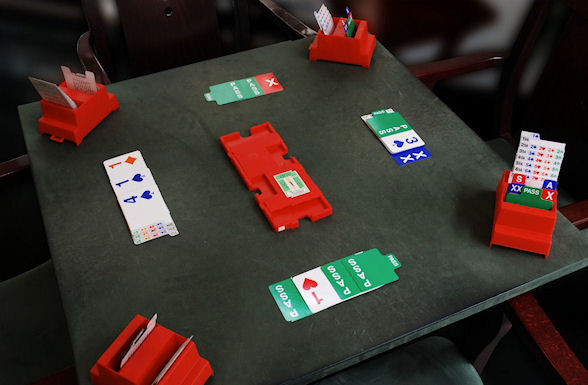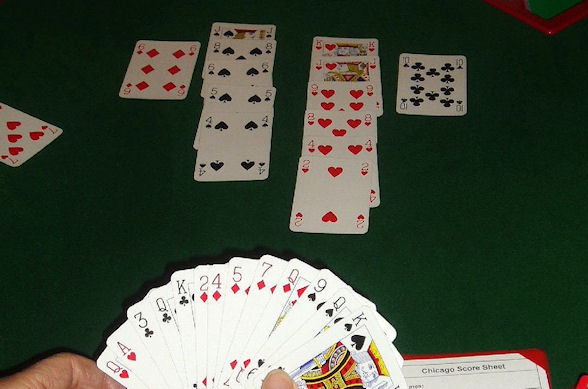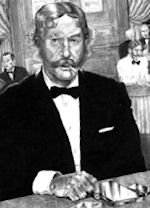This article first appeared in the Mar/Apr 2013 issue of World Gaming magazine.
Bridge remains one of the most played card games in the world. In this article, the first of our series on bridge, we cover the history and basics of playing this great game.

Bridge, more formally known as contract bridge, is a trick-taking card game using a standard 52-card deck, played by millions of people throughout the world. Claimed to be the world’s most popular card game, it is enjoyed in homes and clubs, at tournaments and online. The World Bridge Federation is the governing body for international competitive bridge.
Bridge is derived from the 17th century card game “whist”, which was in vogue among the English nobility of the time and was itself derived from the 16th century card game “trump”. Whist spread to other parts of the world and when it reached the Middle East in the late 19th century, the game evolved into one of the earliest forms of bridge. By the turn of the 20th century two derivatives of early bridge surfaced – “plafond” (a French name meaning “ceiling“) which was dominant in France and “auction bridge” which prevailed elsewhere.

Harold Vanderbilt
In 1925 the wealthy American Harold Vanderbilt had some invaluable idle time on a steamship cruise, which he used to invent contract bridge by combining plafond and auction bridge. The game quickly gained popularity throughout the United States, where it experienced its golden age in the 1930s and 1940s. In the following decades, bridge fever lessened, but a consistent interest in the game remained. Sports Illustrated included regular bridge articles, and Time magazine featured bridge expert Charles Goren, otherwise known as “Mr Bridge”, on an issue cover.
Duplicate bridge, a specialised form of the game very suitable for tournament play, also became a hot activity during the middle of the century. The World Championships, which uses a team variation of duplicate bridge, began in 1950. The World Championships now feature professional bridge players and include open, women’s and seniors competitions named the Bermuda Bowl, Venice Cup and d’Orsi Senior Bowl respectively, after the trophies awarded to the winners.
Contract bridge remains popular around the world today and combines elements of skill and luck as well as being a very social game. It is held in such high regard in Holland that it is taught in public schools. The game is played so much in Iceland that the tiny country of 300,000 produced a world championship-winning team in 1991. Other unlikely hotbeds of bridge include Brazil, Turkey, Israel, and Norway. France won a world championship in 1997, while Italy has put together some of the greatest teams ever. Bridge is one of the few games played today by people of all ages, races, and nationalities.
Taking tricks
Bridge is a trick taking game. A trick consists of a card from each player in turn, usually clockwise around the table. The first card played to each trick is called the “lead”, and may be any card in that player’s hand.
After the lead, the other players are obliged to “follow suit” by playing a card of the same suit as the lead, if they have a card of that suit in their hand. If a player cannot follow suit, he may play any card in his hand. In trick taking games, normally one of the four suits is determined to be a “trump” suit for each particular hand. The method for choosing the trump suit varies from game to game.

Bridge bidding sequence
The winner of a trick is determined as follows:
- If a trick contains no trump card, it is won by the highest card of the suit led
- If a trick contains a trump card, it is won by the highest trump played
Bridge’s basic rules
In its simplest form bridge is played by two competing pairs. More can participate, either as individuals or pairs or as teams of up to six, but we will explain the normal four-player version of the game. The players in each pair sit opposite each other, with each player identified by one of the points of the compass, so North and South play against East and West.
Bridge progresses through four phases:
- the deal (in which all 52 cards are dealt out to the four players, 13 apiece)
- the auction (also known as bidding)
- playing the hand
- scoring the results
The deal and scoring are known as the “procedural” phases, and the auction and the playing of the hand are the actively “competitive” phases.
The Auction
At the heart of bridge is the bidding. Most games with auctions or bids use a brief and simple procedure, but the process in bridge is creative and complex. In bridge, players on both sides bid for their side’s right to choose the trump suit or to play the hand as “no trumps”. In bridge, trumps can be any of five possible “denominations” (also known as “strains”). From lowest to highest they are clubs, diamonds, hearts, spades and “no-trumps”, but this ranking is for bidding purposes only.
Beginning with the dealer each player must bid or pass (make no bid) in turn. Simply put, the goal is to win the bid with a suit in which your side has more cards than the other side has, which will greatly help in winning tricks.
A bid is a number from 1 to 7 plus a denomination (♣, ♦, ♥, ♠ or no trumps). The number, added to 6, indicates how many tricks the bidder’s side will be “contracted” to take, with the denomination bid as trumps, should he win the auction process.
|
Following Suit
|
|
|---|---|
|
Bridge comes from a large family of card games that require you to “follow suit”. This means that you must play the same suit as the “lead” card, if possible. This concept becomes second nature, but can be confusing to new players who are unfamiliar with this process. You might want to start with another “following suit” game like “hearts“, featured in our Mar/Apr 2012 issue. To read this article, go to wgm8.com and type “beware of the queen” (including the quotes) in the search bar.
|
Some examples of the 35 possible bids are:
- 1♣ (the lowest possible bid), indicates 7 tricks with clubs as trumps (1 added to 6 equals 7 tricks)
- 1♦ indicates 7 tricks with diamonds as trumps
- 3♦ indicates 9 tricks with diamonds as trumps
- 3 NT indicates 9 tricks with no trumps
The bidding can start with any opening bid. Each new bid must be higher than the previous bid, by being either the same amount of tricks in a higher-ranking denomination, or a higher number of tricks in any denomination.

The auction ends once three players in a row pass. The last bid becomes the final contract, and the first player of that side to bid the final contracted denomination is deemed the “declarer”. There are some further subtleties to the bidding process that are beyond the scope of this article. If you want to delve deeper into these subtleties, head online to learn more.
Playing the hand
The first action is for the player to the left of the declarer to play the “opening lead” – the first card of the first trick. The next action in the play is for the declarer’s partner, who sits opposite the declarer, to show their cards. This player is now known as the “dummy”, and plays no further part in the round. Their cards are included in the round but are played at the discretion of their partner, the declarer, who calls for cards from the dummy’s hand, or “plays the dummy”, when it is the dummy’s turn.
The exact reason for a dummy hand is hard to explain, but it adds a whole new dimension to the game. A good team can subtly communicate to each other the strength of their respective hands during the auction phase. The proof of this becomes fully evident in the reveal of the dummy hand. This is a much-loved aspect of the game for many a bridge fan, and certainly has the potential to make or break a team!
Except for the duty to follow suit, card play in bridge is a free choice. In some games, like pinochle, you must try to win each trick – not so in bridge. After four cards have been played, the trick is complete. After each trick has been completed, one of the players from the winning side should collect the cards and arrange them neatly so the number of tricks won can be easily counted. Play continues this way for all 13 tricks.
In the next installment of our bridge series, we will explain scoring which involves comparing the number of tricks won to the winning bid.
|
Before Poker, 007 Played Bridge
|
||
|---|---|---|
 Sir Hugo Drax |
In Ian Fleming’s famous 1950s James Bond novel Moonraker, adapted into the 1979 movie of the same name, 007 plays bridge against the evil multi-millionaire industrialist, Sir Hugo Drax. Bond catches Drax cheating by looking at card reflections in his polished cigarette case. Bond manages to “cheat the cheater” – aided by a cocktail of powdered Benzedrine mixed with non-vintage champagne and a deck of stacked cards – winning £15,000 and infuriating the out-smarted Drax.
|
|







